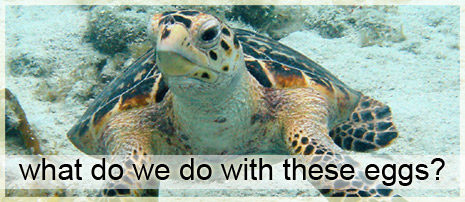
What do we do with these eggs? And this debated question has nothing to do with which came first but is a topic that has been breaking the surf in sea turtle conservation circles. Sea turtlers world-wide have been pondering three possible scenarios for the fate of sea turtle eggs that have been deposited in nests doomed for failure. Whether the nest is vulnerable to tidal inundation or susceptible to erosion, conservation efforts have traditionally included the relocation of eggs in these unsuccessful nests to sites that will triumph. The contention with the traditional relocation approach is a potential meddling of sea turtle gene pools through enabling the survival of hatchlings that would actually have succumbed to Darwin’s survival of the fittest. If nest selection is a heritable trait, then females who select the best sites are crucial for the continued survival of the species and are responsible for their past success. Simply stated, through relocation, humans are imposing artificial selection.
1. Let nature take its course and do not relocate vulnerable eggs
2. Relocate eggs and increase dwindling sea turtle population numbers (and potentially accept a changing gene pool)
3. Commercialize/sell the doomed eggs and use profits for conservation efforts
Although more research is definitely needed, those opposing any type of commercialization received a boost to their argument in a new publication Nest-Site Selection in Individual Loggerhead Turtles and Consequences for Doomed-Egg Relocation.
According to findings, nest site selection is a product of experience rather than genetics. What is most interesting is that there appears to be variability in nest selection, which actually bodes well for long-term survival as the turtles do not necessarily return to the exact same beach but those in a general area. Differences in erosion potential, predation, and profile between beaches enable increased nesting success since females exhibit variable nest-site selection strategies. Thus, a strategy that works on one may not work on the next beach and hence speaks volumes towards the evolutionary accomplishment of marine turtles.
The authors conclude, “Because concerns over distortion of the gene pool have been a major impetus for proposing the commercialization of doomed eggs indicate that such commercialization cannot be justified on this biological basis for at least some, and perhaps most, sea turtle populations. (Pfaller, et al.)”
The argument does beg the question, “What harm will come from selling doomed sea turtle eggs?” I’m sure it is not just me, but something does seem inherently wrong with trafficking in threatened and endangered species products. Firstly, can regulations alone ensure doomed eggs are the only ones that will enter the market? Poaching is already a huge problem with sea turtle eggs and many other commercially viable species. Ensuring that local markets are only providing legally harvested eggs is a daunting management task.
Secondly, a determination must be made as to which nests are indeed doomed and available for harvesting. Some nests will definitely fit a doomed profile, but there is not 100% accuracy in deciding which category a nest should fall…err on the side of caution I suppose. Thirdly, there is the ecologically benefit the doomed eggs provide. Plants, animals, scavengers, etc. rely on the nutrient value of these eggs for survival.
Of course this is only a small piece of the sea turtle puzzle as under optimal circumstances a hands-off approach is always the best course of action. Populations are able to cope with naturally occurring forms of loss such as predation and water inundation, but as habitats decline, human encroachment increases, greed rises, and communities struggle with survival the turtles find themselves on the losing end.

